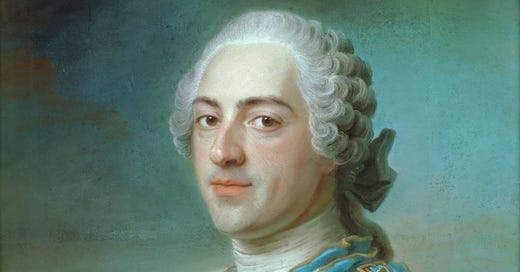Chapter 1.1.I: Louis the Well-Beloved
Background
King Louis le Bien Aimé — the well-beloved — was: not. Some historians have tried to salvage his reputation, but this largely seems like the kind of contrarian “reevaluation” you can build a dissertation on top of. He had a strong taste for hunting and field sports, and an even stronger taste for women, but not so much for royal administration.
The position of chief royal mistresse (maîtresse-en-titre) was, very Frenchly, a semi-official position in the royal household. Louis’ most famous chief mistress was Madame de Pompadour, an influential and competent administrator who held the ‘position’ from 1745 to 1751.
The influence of Louis’ mistresses was a frequent topic of conflict with the nobility, and fighting with them could lead to exile, as it did in 1749 for Louis’ former Minister of the Marine and Secretary of State Maurepas.
At the time Carlyle begins, Louis’ favored mistress is Madame du Barry, a remarkable upstart who was born without a father. She carried enormance influence over the King, and was able to use it to install her allies in positions of authority.
These allies were the so-called Maupeou Triumvirate, consisting of Maupeou (see below), Abbe Terray, and the Duke d'Aiguillon. After a successful power struggle with the parlements (in which Maupeou had wrested authority back to the monarchy) and the Duke de Choiseul, these three men effectively ran Louis’ government.
Notes
President Hénault Charles-Jean-François Hénault d'Armorezan, a writer and historian best known for his Abridged Chronological History of France Until the Death of Louis XIV, which became quite popular. President of the first Chambre des Enquêtes (Chamber of Inquiries), a chamber of the Parlement of Paris that was responsible for conducting investigations.
Little Trianon The Petit Trianon is a château located on the grounds of the Versailles that was constructed between by Louis XV between 1762 and 1768.
Dame Dubarry Madame du Barry was the last maîtresse-en-titre (chief royal mistress) of Louis XV. A controversial figure, she is introduced here with her political allies, with whom she will conspire against the duc de Choiseul and the parlements.
Duke d'Aiguillon Emmanuel-Armand de Richelieu, duc d'Aiguillon was Louis XV's Secretary of State for Foreign Affairs, a position which was achieved for him by his ally Madame du Barry, who had advised restructuring the government to reduce the power and resistance of the parlements.
Maupeou René Nicolas Charles Augustin de Maupeou, ally of d’Aiguillon and du Barry against Choiseul and the parlements, was the Chancellor of France (responsible for the judiciary) under Louis XV
Choiseul Étienne François, duc de Choiseul, the Foreign Minister of France from 1758-1761 and 1766-1770. He was conspired against and eventually ousted by Dubarry, d’Aiguillon and company. The culminating struggle came over the question of France’s involvement in a dispute between Britain and Spain over the Falkland Islands, with Choiseul advocating heavy anti-British involvement.
from the Mill of St. Cast, on Quiberon and the invading English The Duke d’Aiguillon had in 1759 taken part in a large-scale invasion of Great Britain that was thwarted by the French naval defeat at Quiberon Bay. Shortly afterward, he came into conflict with the parlement of Brittany and its procureur La Chalotais over an issue of taxation, which brought him also into conflict with the Duc de Choiseul.
Abbé Terray Joseph Marie Terray, made Controller-General of Finances by Maupeou. While technically a priest, he was known for his dissolute morals. He played role in ousting of Choiseul by arguing that France could not afford to go war with Great Britain.
Domdaniel Domdaniel is a cavern at the bottom of the ocean where evil magicians, spirits, and gnomes meet.
Armida-Palace Armida is a Saracen (Arabian) sorceress.
fair haughty Châteauroux Marie Anne de Mailly-Nesle, duchesse de Châteauroux was (along with three of her sisters) a mistress of Louis XV. She was his mistress from 1742-1744, and so during the time of the illness at Metz which led to Louis’ “Bien Aimé”.
shaveling Nickname for a tonsured clergyman or monk, derogatory
Pompadour Madame de Pompadour, maîtress-en-titre from 1745-1751, was an influential and competent member of the court who remained powerful until her death.
Damiens In 1757, Robert-François Damiens attempted to assassinate Louis XV with a penknife. The affair scared Louis enough to ask for a confessor and repent of his numerous affairs, even denouncing Madame de Pompadour for a time. Damiens was the last person executed in France by dismemberment. Some of his immediate family members were exiled, while the others had to change their names.
Rossbach victories In 1757, during the Seven Year's War’s Third Silesian War, Frederick the Great’s Prussian army defeated French forces at the Battle of Rossbach
Lettres de Cachet Lettres de cachet (letters of the [royal] mark), notorious as a symbol of the ancien régime, were letters stamped by the King which transmitted orders or edicts that could not be appealed. They were often used to strong-arm the parlements.
Bicêtre Hospital Originally a military hospital, the Hôpital Bicêtre was at this time a prison described as “much more terrible than the Bastille”. It later became an insane asylum.
Regrater of Bread Regrate: to buy and sell again in the same market, thereby raising the price.
tant pis pour lui “Too bad for him”



